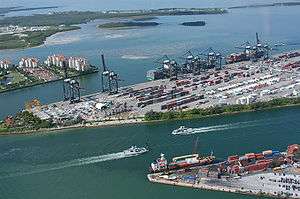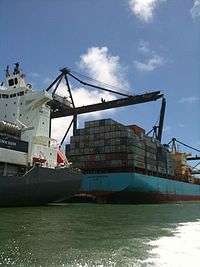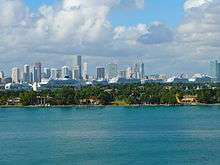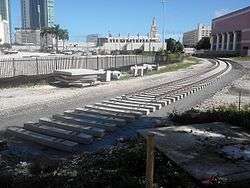PortMiami
| PortMiami | |
|---|---|
 Aerial view of PortMiami | |
| Location | |
| Country | United States |
| Location | Miami, Florida |
| Coordinates | 25°46′27″N 80°10′16″W / 25.77417°N 80.17111°W |
| Details | |
| Type of harbor | Natural/Artificial |
| Employees | 176,000 |
| Port Director | Juan Kuryla |
| Statistics | |
| Vessel arrivals | 2,489 |
| Annual cargo tonnage | 7.42 million |
| Passenger traffic | 4.33 million |
| Annual revenue | $94.70 million |
| Formerly | Port of Miami |
|
Website PortMiami | |
| Part of the series on |
| Florida Ports |
|---|
 |
| Ports |
|
| Wikipedia:WikiProject Florida |
PortMiami, formally the Dante B. Fascell Port of Miami, is a major seaport located in Biscayne Bay in Miami, Florida. It is the largest passenger port in the world, and one of the largest cargo ports in the United States. It is connected to Downtown Miami by Port Boulevard—a causeway over the Intracoastal Waterway—and to the neighboring Watson Island via the PortMiami Tunnel.[1] The port is located on Dodge Island, which is the combination of three historic islands (Dodge, Lummus and Sam's Islands) that have since been combined into one. It is named in honor of 19 term Florida Congressman Dante Fascell.[2][3]
As of 2011, PortMiami accounts for 176,000 jobs and has an annual economic impact in Miami of $18 billion.
History
In the early 1900s, Government Cut was dredged along with a new channel to what now is known as Bicentennial Park in downtown Miami[4]. This new access to the mainland created the Main Channel which greatly improved the shipping access to the new port. From these original dredging spoils which were disposed on the south side of the new Main Channel, new islands were inadvertently created which later became Dodge, Lummus and Sam's Island along with several other smaller islands.
As the port grew through the years as a result of the improved shipping access and growth of the South Florida community, it also needed additional lands to expand its operation. As such, on April 5, 1960 the Dade County Board of Commissioners approved Resolution No. 4830, "Joint Resolution Providing for Construction of Modern Seaport Facilities at Dodge Island Site" which on April 6, 1960 the City of Miami approved the same as City Resolution No. 31837 to construct the new Port of Miami. Soon thereafter, work began on constructing the new port on Dodge Island by expanding the island and joining it other islands in the general vicinity. Then upon construction of the new seawalls, transit shed 'A', the administration building and a new vehicle and railroad bridge, the operations were transferred from the mainland port to the new port on Dodge Island. Thereafter through the years, additional fill material from dredging enlarged the islands of Lummus and Sam's along with the filling of the North, South and NOAO slips, creating the new port which is built on a completely man made island.
Today

PortMiami boasts the title "cruise capital of the world", and is the busiest cruise/passenger port in the world.[5][6][7] It accommodates the operations of such major cruise lines as Carnival, Royal Caribbean and Norwegian Cruise Line. It was home of the largest cruise ships in the world until 2009, when Port Everglades became home to Oasis of the Seas and its sister ship, Allure of the Seas. Currently the following ships are based in Miami: Carnival Vista, Carnival Sensation, Carnival Glory, Carnival Victory, Carnival Splendor, Enchantment of the Seas, Empress of the Seas, Navigator of the Seas, Norwegian Getaway, Norwegian Escape, Norwegian Sky, Disney Magic.
In 2018, PortMiami became homeport for five more modern megaliners: Mariner of the Seas, Allure of the Seas, Symphony of the Seas, Carnival Horizon, and Norwegian Bliss.[8]
As the "Cargo Gateway of the Americas", the port primarily handles containerized cargo with small amounts of breakbulk, vehicles and industrial equipment. It is the largest container port in the state of Florida and ninth in the United States. As a world-class port, PortMiami is among an elite group of ports in the world which cater to both cruise ships and containerized cargo.
PortMiami is an important contributor to the local south Florida and state economies. Over four million cruise passengers pass through the Port, 7.4 million tons of cargo and over 1 million twenty-foot equivalent units (TEU) (FY 2004/2005) of intermodal container traffic move through the seaport per year. This combination of cruise and cargo activities supports approximately 176,000 jobs, and has an economic impact in Miami-Dade County of over $17 billion, $14 billion of which is generated by its cargo operations.
The port currently operates eight passenger terminals, six gantry cranes wharves, seven Ro-Ro (Roll-on-Roll-off) docks, four refrigerated yards for containers, break bulk cargo warehouses and nine gantry container handling cranes. In addition, the port tenants operate the cruise and cargo terminals which includes their cargo handling and support equipment.

To retain the port's competitive rank as a world-class port, in 1997 the port undertook a redevelopment program of over $250 million which is well underway to accommodate the changing demands of cruise vessel operators, passengers, shippers and carriers. To further resolve accessibility, the PortMiami Tunnel was constructed in 2010 and completed in 2014, providing direct vehicle access from the port to the interstate highway system via State Road 836, thereby bypassing congestion in downtown Miami.[1]
As part of the massive PortMiami redevelopment program, new ultramodern cruise terminals, roadways and parking garages have been constructed. Additionally, a new gantry crane dock and container storage yards have been constructed along with the electrification of the gantry crane docks to include the conversion of several cranes has been completed. In addition, the Port acquired two state-of-the-art super post-panamax gantry cranes which are amongst the largest in the world; able to load and unload 22 container (8 foot wide each), or nearly 200 foot, wide mega container ships. This, along with the planned Deep Dredge Project, would make it possible for PortMiami to facilitate even the future largest containerships in the world, the Maersk Triple E Class. The new and restructured roadway system with new lighting, landscaping and signage greets visitors to the 'Cruise Capital of the World and Cargo Gateway of the Americas'. The roadways will change again with the completion of the PortMiami Tunnel. And to enhance cargo port accessibility, the newly constructed Security Gates opened at the end of 2006 to increase the processing rate for container trucks and help eliminate the daily traffic backups.
In March 2018, Norwegian Cruise Line Holdings unveiled details on the new NCL-dedicated terminal at PortMiami. The company intends to open it by fall 2019.[9]
In July 2018, MSC Cruises announced its plans to build Terminal AAA for its upcoming World-class cruise ships.[10]
Tunnel and Deep Dredge
There are four major projects related to PortMiami which are all scheduled to be ready by 2014: the expansion of the Panama Canal, the PortMiami Deep Dredge Project, the PortMiami Tunnel, and the restoration of the bridge and rail line connecting the PortMiami to the mainland.
On May 24, 2010, construction began on the Miami Port Tunnel, a $1 billion project that will connect the port to other major highway arteries, including I-395. Construction is set to finish by 2014.
Another major development for the PortMiami is the PortMiami Deep Dredge project that will allow Super Post Panamax Megaships to enter the United States after the completion of the Panama Canal expansion in 2014. The ports of Norfolk, New York and Baltimore have deepened their ports to the required 50 feet. With the correct funding, the PortMiami estimates that it is capable of completing such a project by 2014. It is also estimated that this project could double Miami's cargo business in the next 10 years as well as creating over 30,000 permanent jobs for Miami, which currently has a very high unemployment rate.
There have also been plans to build a soccer-specific stadium at PortMiami. The plans were proposed by a group, led by David Beckham, seeking to bring a Major League Soccer team to Miami.[11] The group has stated that they would fund such a stadium privately, but there has been opposition on multiple grounds, including the added traffic to downtown Miami and the impact on wildlife.[12]
Railroad access

In 2011, PortMiami was awarded a federal grant, as part of the Transportation Investment Generating Economic Recovery (TIGER) program, to restore a connection between the Florida East Coast Railway's yard in Hialeah and the PortMiami, directly connecting the port to rail networks across the United States,[13] as well as re-establishing the port's on-dock rail capability (loading and unloading directly between ships and trains).[14] The railroad bridge connecting the PortMiami to the mainland was damaged by Hurricane Wilma in 2005, at which time service was suspended.[15] The project was scheduled to be finished in time for the completion of the other projects in 2014.[16] The rail project is related to another scheme to increase PortMiami's capacity; an inland intermodal center, known as Flagler Logistics Hub, to be built to be built near the airport on 300 acres of land in Hialeah.[17]
There was some opposition to the railroad line being returned to service, with claims that it would be as much of a problem to downtown traffic as container trucks, and that the noise would be a disturbance to nearby residents. However, trains are occasional and will be reserved for specialty freight, such as oversized loads and hazardous materials, which will be banned from the tunnel. As well, trains will be able to travel at up to 30 mph (50 km/h) on the newly renovated line, in contrast to the old limit of 5 mph (8 km/h),[18] and so will be able to cross Biscayne Boulevard in 90 seconds.[19] The current plan is for the line to be strictly for intermodal services, with the project including a rail yard and station at the port. However, a passenger station may be added in the future.[20]
The cost of restoring the rail link between the port and the Hialeah Railyard was estimated at $46.9 million, $28 million of which was applied for through a federal grant in 2010.[16] Later that year, a grant of $22 million was awarded for this project,[21] as well as to build an on site intermodal rail yard at the port. During the 2000s the percent of Florida East Coast Railway's business has increased from around 60% to around 80% intermodal freight.[22] However, this was partially due to a decrease in other freight traffic caused by the 2008 recession, which reduced the number of trains, many carrying rock aggregate used in construction, from about 20 to 14 per day.[23]
There is also a plan to start a passenger service connecting Jacksonville to Miami using the FECR mainline, with stops at popular tourist attractions. The State of Florida has provided $116 of the $268 million needed to fund that project.[24] The remaining funding for the passenger line is expected to come from a federal grant, and the remaining funding to fix the local freight line from the Port to Hialeah is supposed to come from the Florida East Coast Railroad (FEC) at $10.9 million, the Florida Department of Transportation (FDOT) at $10.9 million, with the PortMiami itself[16] providing $4.8 million.[19] In April 2011, Atlas Railroad Construction was chosen to rebuild the line, which was to be completed by 2012 and was estimated to remove 5% of the road traffic from the port.[25] On July 15, 2011, a ground-breaking ceremony marking the beginning of the rail link project, which is expected to create over 800 jobs and generate $33.38 million in wages, was performed by US Senator Bill Nelson, Secretary of Transportation Ray LaHood, Miami-Dade Mayor Carlos Giménez, and Miami city mayor Tomás Regalado.[19] The project has been named the PortMiami Intermodal and Rail Reconnection Project.[13]
See also
References
- 1 2 Chardy, Alfonso (May 17, 2014). "Decades after conception, Miami has a port tunnel". Miami Herald. Retrieved June 6, 2014.
- ↑ "PortMiami makes history - Historic Marker Unveiled". Port of Miami. September 14, 2014. Retrieved November 15, 2014.
- ↑ "Contact PortMiami". PortMiami. Miami-Dade County. Retrieved 16 June 2017.
- ↑ "PortMiami Government Cut Bicentennial".
- ↑ "PortMiami 2017 Cruise Guide" (PDF). miamidade.gov. PortMiami. Retrieved 16 June 2017.
- ↑ "See which Florida cruise ports are among the largest in the world". bizjournals.com. Orlando Business Journal.
- ↑ "The World's Busiest Cruise Ports". The Telegraph. Retrieved 16 June 2017.
- ↑ "5 New Cruise Ships Coming to PortMiami Later This Year". cruisefever.net. Retrieved 2018-07-09.
- ↑ Staff, CIN (2018-03-07). "Norwegian Cruise Line Holdings Announces New Terminal at PortMiami". Retrieved 2018-03-09.
- ↑ "MSC Cruises to Build Second Cruise Terminal in Miami - MSC Cruises". www.cruisecritic.com. Retrieved 2018-07-12.
- ↑ Report: David Beckham, MLS Commissioner Don Garber to address Miami expansion plans next week | MLSsoccer.com
- ↑ http://www.dailystar.co.uk/news/latest-news/392373/EXCLUSIVE-David-Beckham-s-Miami-stadium-hopes-rekindled-by-outpost-offer
- 1 2 Jeanette Sheppard, Hank Tester (July 15, 2011). "Port of Miami Rail Project Groundbreaking". NBC Miami. Retrieved 2011-07-16.
- ↑ "Miami port rail link construction set". Railway Age. July 13, 2011. Archived from the original on September 27, 2011. Retrieved 2011-07-16.
- ↑ "Back to the Future: Port of Miami & Florida East Coast Railway?". MiamiDade.gov. 2010. Retrieved 2011-03-30.
- 1 2 3 Alfonso Chardy (August 21, 2010). "Port of Miami puts rail project on fast track". Miami Herald. Retrieved 2011-03-30.
- ↑ Zachary S. Fagenson (March 10, 2011). "Million-square-foot Flagler logistics hub key piece of Miami's international trade puzzle". Miami Today News. Retrieved 2011-03-30.
- ↑ "Port of Miami rail connection breaks ground". WSVN-TV. July 15, 2011. Retrieved 2011-07-16.
- 1 2 3 Ashley D. Torres (July 15, 2011). "FEC rail project starts – 800 jobs expected". South Florida Business Journal. Retrieved 2011-07-17.
- ↑ "TIGER II Grant". Miami-Dade.gov. 2010. Retrieved 2011-04-11.
- ↑ "Port of Miami Cargo". Edward Redlich. October 14, 2010. Retrieved 2011-04-06.
- ↑ James R. Hertwig (April 4, 2011). "Historic Florida railroad has eyes on business from wider Panama Canal". Sun-Sentinel. Retrieved 2011-04-13.
- ↑ Kevin Gale (April 1, 2011). "Florida East Coast Railway pulls the throttle on intermodal business". South Florida Business Journal. Retrieved 2011-04-14.
- ↑ William Lind (April 13, 2011). "A Test for Florida's Governor". The Conservative American. Retrieved 2011-04-14.
- ↑ Zachary Fagenson (June 2, 2011). "Florida East Coast Rail line to haul 5% of cargo trucks from Port of Miami". Miami Today. Retrieved 2011-06-02.
